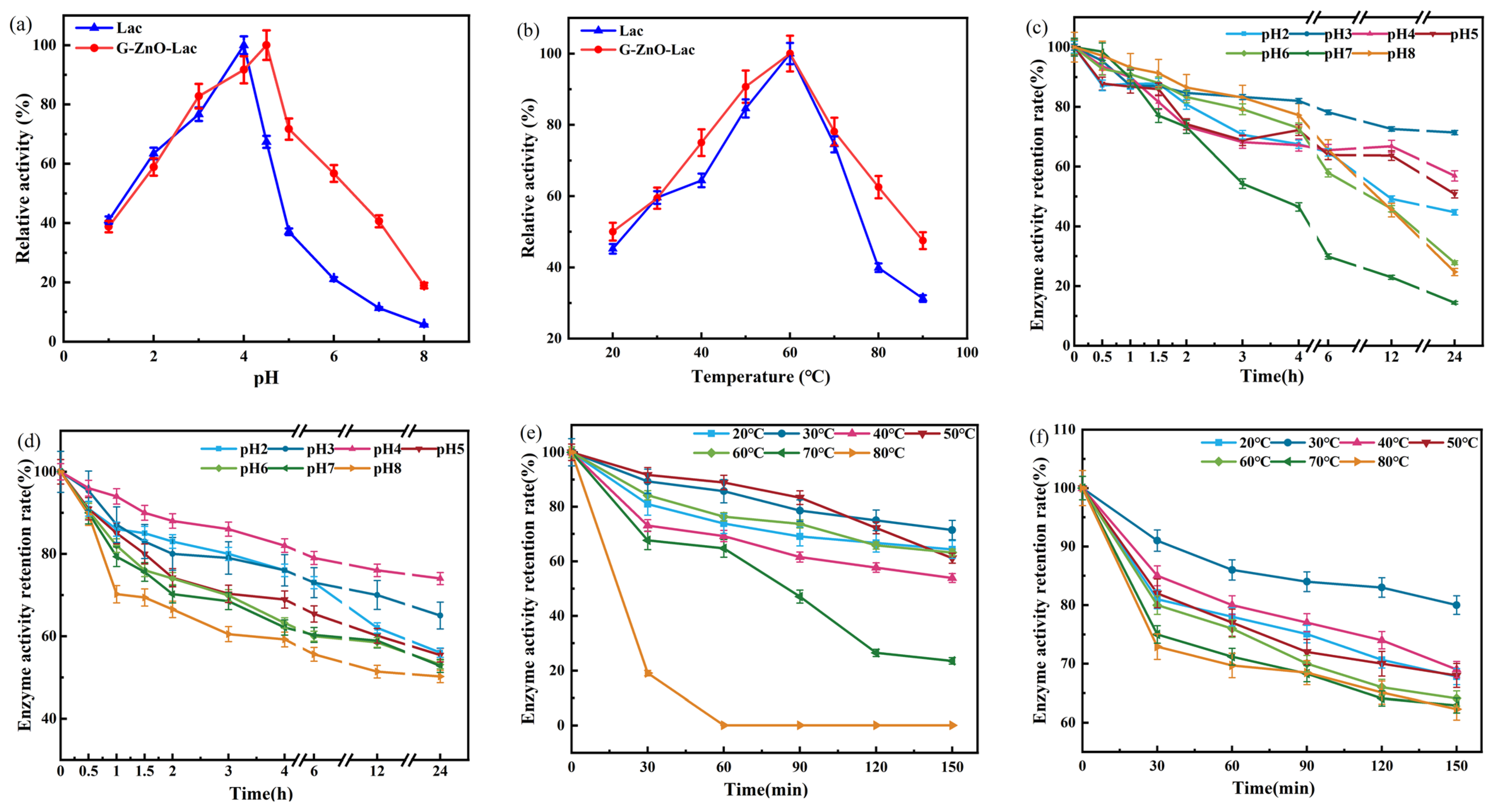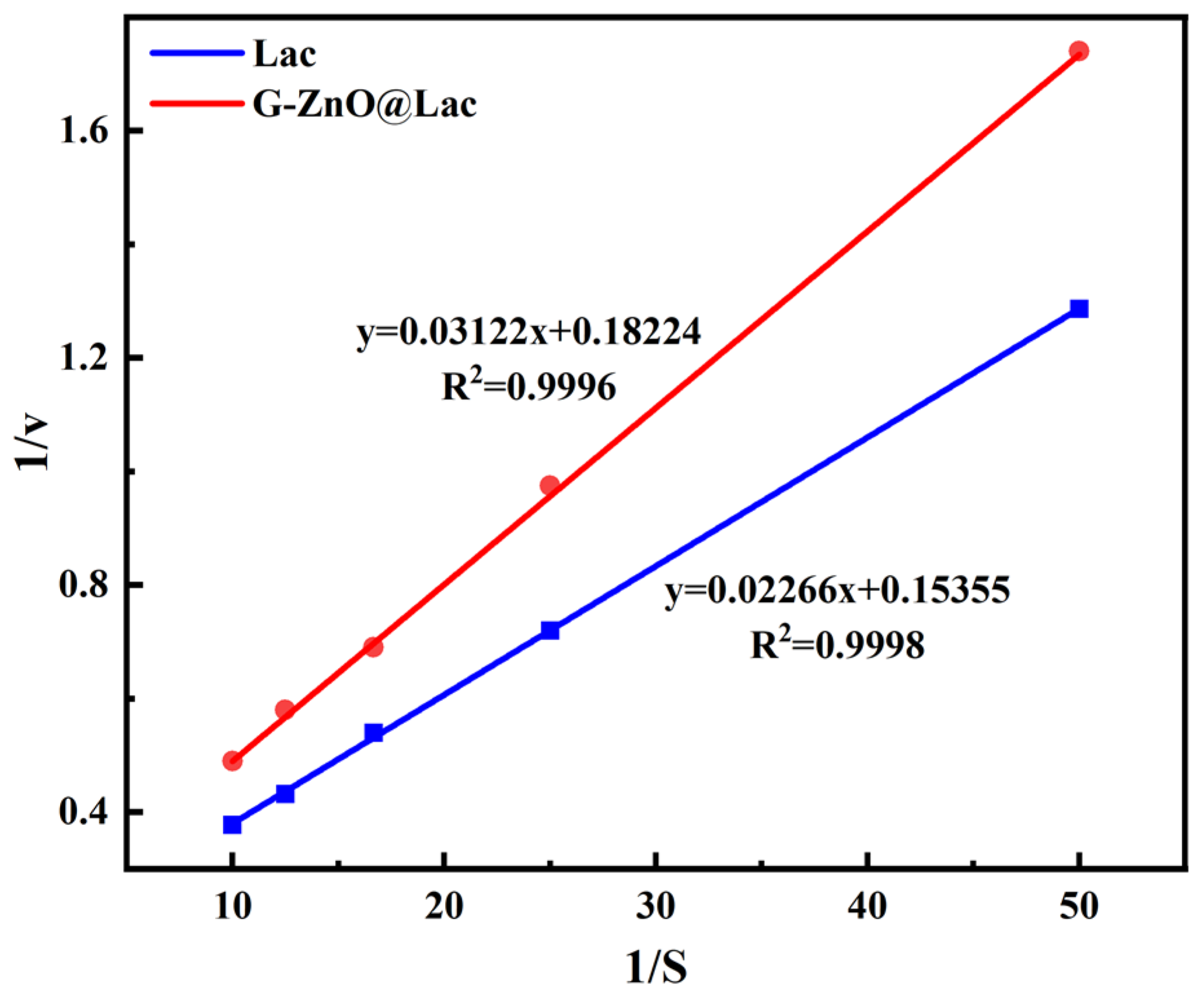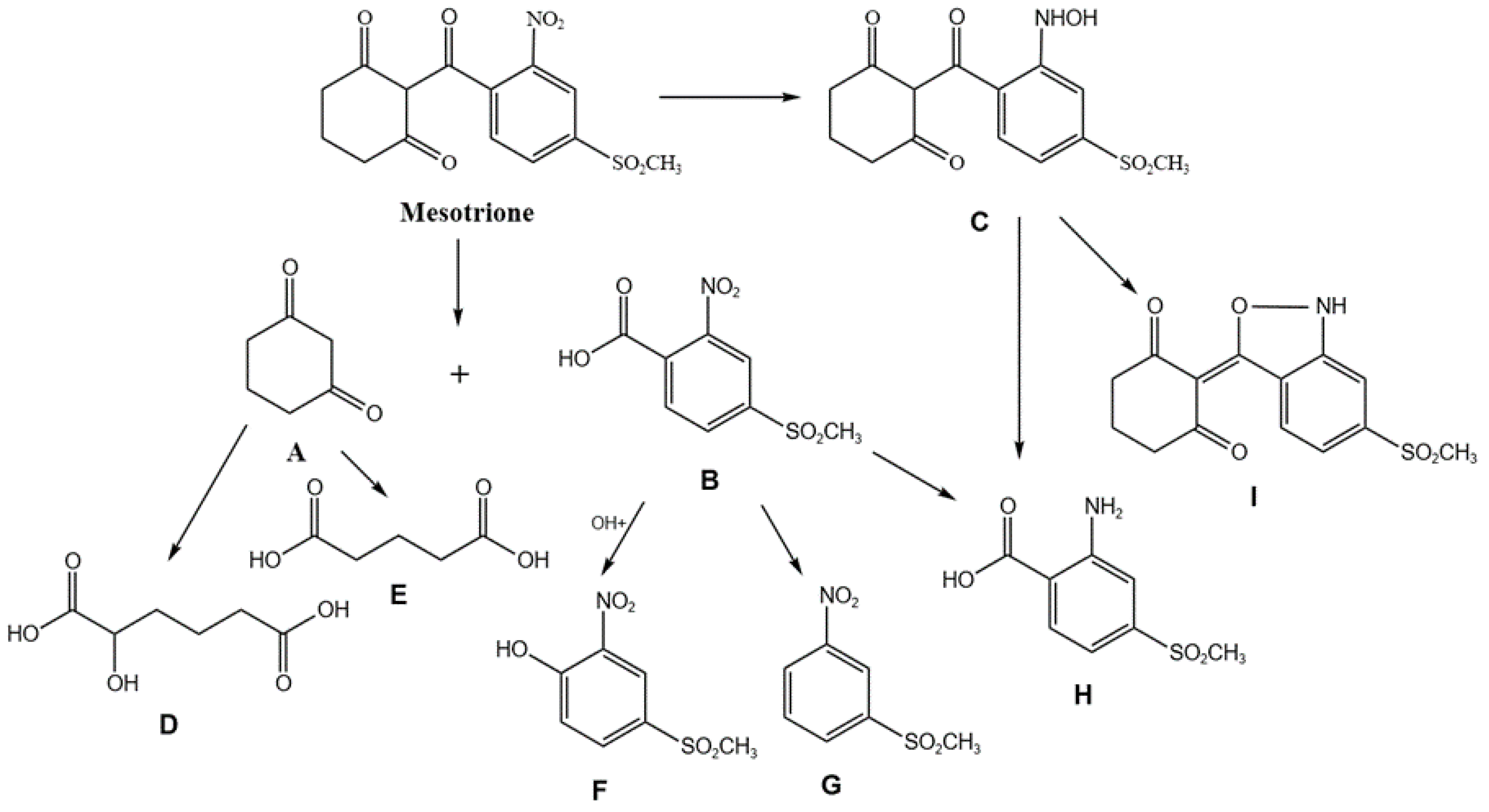Construction of Immobilized Laccase System Based on ZnO and Degradation of Mesotrione
Abstract
1. Introduction
2. Materials and Methods
2.1. Materials
2.2. Preparation and Characterization of ZnO Nanomaterials
2.3. Determination of Laccase Activity
2.4. Relative Enzyme Activity and Enzyme Recovery Rate
2.5. Determination of Laccase Immobilization Capacity
2.6. Preparation of Immobilized Laccase
2.7. Determination of Kinetic Constants
2.8. Detection and Extraction of MES
2.9. Data Analysis
3. Results and Discussion
3.1. Morphological Characterization of Nano-ZnO
3.2. Comparison of Performance of ZnO@Lac with Different Morphologies
3.3. Characterization of Free Laccase and Immobilized Laccase
3.4. Construction of Immobilized Laccase System
3.4.1. pH and Temperature Stability of Laccase and Immobilized Laccase
3.4.2. Storage Stability of Laccase and Immobilized Laccase
3.4.3. Reusability of Immobilized Laccase
3.4.4. Kinetic Parameters
3.5. Optimization of Degradation Conditions of MES by Immobilized Laccase
3.6. Analysis of the Degradation Mechanism of Mesotrione
4. Conclusions
Author Contributions
Funding
Institutional Review Board Statement
Informed Consent Statement
Data Availability Statement
Acknowledgments
Conflicts of Interest
References
- Bo, H.; Dawei, W.; Wenchao, Y.; Qiong, C.; Guangfu, Y. Advances in Research on 4-Hydroxyphenylpyruvate Dioxygenase (HPPD) Structure and Pyrazole-Containing Herbicides. Chin. J. Org. Chem. 2017, 37, 2895–2904. [Google Scholar]
- Rouchaud, J.; Neus, O.; Cools, K.; Bulcke, R. Dissipation of the triketone mesotrione herbicide in the soil of corn crops grown on different soil types. Toxicol. Environ. Chem. 2000, 77, 31–40. [Google Scholar] [CrossRef]
- Mandeep, S.; Saania, B.; Mohan Krishna, D.; Jassasvi, P.; Sandeep, M.; Gurpreet, S. Effect of pre- and post-emergence (HPPD-Inhibitors) herbicides on weed dynamics and yield of kharif Maize (Zea mays). Ecol. Environ. Conserv. 2024, 29, 1568–1571. [Google Scholar] [CrossRef]
- Xiaotian, C.; Yuanfu, L.; Wei, L.; Ning, H.; Feng, Z.; Ping, H.; Huihua, T. Biodegradation properties and mechanism of triketone herbicide mesotrione via newly isolated bacterium Klebsiella pasteurii CM-1. Int. Biodeterior. Biodegrad. 2024, 187, 105727. [Google Scholar] [CrossRef]
- Araújo, R.D.S.; Viana, T.A.; Botina, L.L.; Bastos, D.S.S.; da Silva Alves, B.C.; Machado-Neves, M.; Bernardes, R.C.; Martins, G.F. Investigating the effects of mesotrione/atrazine-based herbicide on honey bee foragers. Sci. Total Environ. 2023, 898, 165526. [Google Scholar] [CrossRef] [PubMed]
- Haoyu, Z.; Shiqi, N.; Zhonghua, W. Effect of single and combined stress of mesotrione and copper on the growth and physiology of Vallisneria natans. Biot. Resour. 2023, 45, 572–583. [Google Scholar] [CrossRef]
- Giardina, A.; Tampieri, F.; Biondo, O.; Marotta, E.; Paradisi, C. Air non-thermal plasma treatment of the herbicides mesotrione and metolachlor in water. Chem. Eng. J. 2019, 372, 171–180. [Google Scholar] [CrossRef]
- Zhao, H.; Zhang, Q. Performance of electro-Fenton process coupling with microbial fuel cell for simultaneous removal of herbicide mesotrione. Bioresour. Technol. 2020, 319, 124244. [Google Scholar] [CrossRef]
- Carles, L.; Joly, M.; Bonnemoy, F.; Leremboure, M.; Donnadieu, F.; Batisson, I.; Besse-Hoggan, P. Biodegradation and toxicity of a maize herbicide mixture: Mesotrione, nicosulfuron and S-metolachlor. J. Hazard. Mater. 2018, 354, 42–53. [Google Scholar] [CrossRef]
- Liu, Y.; Liu, W.; Li, M.; Liu, S.; Peng, D.; Zhao, F.; Wu, X.; Tan, H. Biodegradation characteristics and mechanism of terbuthylazine by the newly isolated Agrobacterium rhizogenes strain AT13. J. Hazard. Mater. 2023, 456, 131664. [Google Scholar] [CrossRef]
- Xu, K.; Racine, F.; He, Z.; Juneau, P. Impacts of hydroxyphenylpyruvate dioxygenase (HPPD) inhibitor (mesotrione) on photosynthetic processes in Chlamydomonas reinhardtii. Environ. Pollut. 2018, 244, 295–303. [Google Scholar] [CrossRef]
- Huang, M.T.; Lu, Y.C.; Zhang, S.; Luo, F.; Yang, H. Rice (Oryza sativa) Laccases Involved in Modification and Detoxification of Herbicides Atrazine and Isoproturon Residues in Plants. J. Agric. Food Chem. 2016, 64, 6397–6406. [Google Scholar] [CrossRef] [PubMed]
- Zeng, S.; Qin, X.; Xia, L. Degradation of the herbicide isoproturon by laccase-mediator systems. Biochem. Eng. J. 2017, 119, 92–100. [Google Scholar] [CrossRef]
- Bento, I.; Silva, C.S.; Chen, Z.; Martins, L.O.; Lindley, P.F.; Soares, C.M. Mechanisms underlying dioxygen reduction in laccases. Structural and modelling studies focusing on proton transfer. BMC Struct. Biol. 2010, 10, 28. [Google Scholar] [CrossRef] [PubMed]
- Jafari, M.; Mojtabavi, S.; Faramarzi, M.A.; Mehrnejad, F.; Soleimani, M.; Mirjani, R. Molecular level insight into stability, activity, and structure of Laccase in aqueous ionic liquid and organic solvents: An experimental and computational research. J. Mol. Liq. 2020, 317, 113925. [Google Scholar] [CrossRef]
- Arregui, L.; Ayala, M.; Gómez-Gil, X.; Gutiérrez-Soto, G.; Hernández-Luna, C.E.; Herrera de Los Santos, M.; Levin, L.; Rojo-Domínguez, A.; Romero-Martínez, D.; Saparrat, M.C.N.; et al. Laccases: Structure, function, and potential application in water bioremediation. Microb. Cell Fact. 2019, 18, 200. [Google Scholar] [CrossRef] [PubMed]
- Dong, C.-D.; Tiwari, A.; Anisha, G.S.; Chen, C.-W.; Singh, A.; Haldar, D.; Patel, A.K.; Singhania, R.R. Laccase: A potential biocatalyst for pollutant degradation. Environ. Pollut. 2023, 319, 120999. [Google Scholar] [CrossRef]
- Martínková, L.; Křístková, B.; Křen, V. Laccases and Tyrosinases in Organic Synthesis. Int. J. Mol. Sci. 2022, 23, 3462. [Google Scholar] [CrossRef] [PubMed]
- Chen, H.; Ji, A.; Qiu, S.; Liu, Y.; Zhu, Q.; Yin, L. Covalent conjugation of bovine serum album and sugar beet pectin through Maillard reaction/laccase catalysis to improve the emulsifying properties. Food Hydrocoll. 2018, 76, 173–183. [Google Scholar] [CrossRef]
- Ariaeenejad, S.; Motamedi, E.; Salekdeh, G.H. Highly efficient removal of dyes from wastewater using nanocellulose from quinoa husk as a carrier for immobilization of laccase. Bioresour. Technol. 2022, 349, 126833. [Google Scholar] [CrossRef]
- Wei, Y.; Zhu, Q.; Xie, W.; Wang, X.; Li, S.; Chen, Z. Biocatalytic enhancement of laccase immobilized on ZnFe2O4 nanoparticles and its application for degradation of textile dyes. Chin. J. Chem. Eng. 2024, 68, 216–223. [Google Scholar] [CrossRef]
- Bautista, L.F.; Morales, G.; Sanz, R. Biodegradation of polycyclic aromatic hydrocarbons (PAHs) by laccase from Trametes versicolor covalently immobilized on amino-functionalized SBA-15. Chemosphere 2015, 136, 273–280. [Google Scholar] [CrossRef] [PubMed]
- Cheng, T.; Hui, L.; Yuhai, M.; Junqi, L.; Xiaoxu, L.; Lingyan, P. In-situ growth of enzyme/copper phosphate hybrids on carbon cloth surface as self-powered electrochemical glucose biosensor. Biochem. Eng. J. 2023, 193, 108860. [Google Scholar] [CrossRef]
- Yang, X.; Chen, X.; Wang, H.; Cavaco-Paulo, A.; Su, J. Co-immobilizing laccase-mediator system by in-situ synthesis of MOF in PVA hydrogels for enhanced laccase stability and dye decolorization efficiency. J. Environ. Manag. 2024, 353, 120114. [Google Scholar] [CrossRef]
- Zayed, M.E.M.; Obaid, A.Y.; Almulaiky, Y.Q.; El-Shishtawy, R.M. Enhancing the sustainable immobilization of laccase by amino-functionalized PMMA-reinforced graphene nanomaterial. J. Environ. Manag. 2023, 351, 119503. [Google Scholar] [CrossRef]
- Jeong, J.; Ha, T.H.; Chung, B.H. Enhanced reusability of hexa-arginine-tagged esterase immobilized on gold-coated magnetic nanoparticles. Anal. Chim. Acta 2006, 569, 203–209. [Google Scholar] [CrossRef]
- Florencia Alejandra, B.; Gustavo Raúl, K.; Juan Ernesto, V.; Marcela Alejandra, S.; María Isabel, F.; Alicia Esther, A.; Pedro Darío, Z. Laccase immobilization on nanoporous aluminum oxide for black liquor treatment. Surf. Interfaces 2022, 30, 101879. [Google Scholar] [CrossRef]
- Chaudhary, S.; Umar, A.; Bhasin, K.; Baskoutas, S. Chemical Sensing Applications of ZnO Nanomaterials. Materials 2018, 11, 287. [Google Scholar] [CrossRef] [PubMed]
- Kumar, R.; Umar, A.; Kumar, G.; Nalwa, H.S. Antimicrobial properties of ZnO nanomaterials: A review. Ceram. Int. 2017, 43, 3940–3961. [Google Scholar] [CrossRef]
- Li, Y.; Li, J.; Li, M.; Sun, J.; Shang, X.; Ma, Y. Biological mechanism of ZnO nanomaterials. J. Appl. Toxicol. 2023, 44, 107–117. [Google Scholar] [CrossRef]
- Isanapong, J.; Pornwongthong, P. Immobilized laccase on zinc oxide nanoarray for catalytic degradation of tertiary butyl alcohol. J. Hazard. Mater. 2021, 411, 125104. [Google Scholar] [CrossRef]
- Rani, M.; Shanker, U.; Chaurasia, A.K. Catalytic potential of laccase immobilized on transition metal oxides nanomaterials: Degradation of alizarin red S dye. J. Environ. Chem. Eng. 2017, 5, 2730–2739. [Google Scholar] [CrossRef]
- Shaba, E.Y.; Jacob, J.O.; Tijani, J.O.; Suleiman, M.A.T. A critical review of synthesis parameters affecting the properties of zinc oxide nanoparticle and its application in wastewater treatment. Appl. Water Sci. 2021, 11, 48. [Google Scholar] [CrossRef]
- Saito, N.; Haneda, H. Hierarchical structures of ZnO spherical particles synthesized solvothermally. Sci. Technol. Adv. Mater. 2011, 12, 064707. [Google Scholar] [CrossRef]
- Turan, G.; Cevher Kursat, M.; Fatih, B.; Ezgi, G.; Cihan, O.; Stefano, B. Investigation of dielectric parameters and AC conductivity of ZnO: TiC nanocomposite powders. Appl. Phys. A 2023, 129, 649. [Google Scholar] [CrossRef]
- Zdarta, J.; Feliczak-Guzik, A.; Siwińska-Ciesielczyk, K.; Nowak, I.; Jesionowski, T. Mesostructured cellular foam silica materials for laccase immobilization and tetracycline removal: A comprehensive study. Microporous Mesoporous Mater. 2019, 291, 109688. [Google Scholar] [CrossRef]
- Zhang, Y.; Piao, M.; He, L.; Yao, L.; Piao, T.; Liu, Z.; Piao, Y. Immobilization of laccase on magnetically separable biochar for highly efficient removal of bisphenol A in water. RSC Adv. 2020, 10, 4795–4804. [Google Scholar] [CrossRef] [PubMed]
- Ruqayah Ali, G.; Osamah, J.A.-s.; Mónika, M.; Csilla, S.-K.; Raed, A.A.-J.; Miklós, J.; Edina, L.; Viola, S.; Mohammad Amir, K.; Khalid, S.H. A sustainable nano-hybrid system of laccase@M-MWCNTs for multifunctional PAHs and PhACs removal from water, wastewater, and lake water. Environ. Res. 2024, 246, 118097. [Google Scholar] [CrossRef]
- Lihui, W.; Huan, L.; Heyu, L.; Xiaobing, Z.; Yanjun, J.; Jing, G. Preparation and application of core-shell hydrophobic magnetic dendritic fibrous organosilica immobilized lipase. CIESC J. 2021, 72, 4861–4871. [Google Scholar]
- Sun, H.; Yuan, F.; Jia, S.; Zhang, X.; Xing, W. Laccase encapsulation immobilized in mesoporous ZIF-8 for enhancement bisphenol A degradation. J. Hazard. Mater. 2022, 445, 130460. [Google Scholar] [CrossRef]
- Drozd, R.; Rakoczy, R.; Wasak, A.; Junka, A.; Fijałkowski, K. The application of magnetically modified bacterial cellulose for immobilization of laccase. Int. J. Biol. Macromol. 2017, 108, 462–470. [Google Scholar] [CrossRef] [PubMed]
- Amin, R.; Khorshidi, A.; Bensch, W.; Senkale, S.; Faramarzi, M.A. Degradation of Sesame Oil Phenolics Using Magnetic Immobilized Laccase. Catal. Lett. 2020, 150, 3086–3095. [Google Scholar] [CrossRef]
- dos Santos, K.P.; Rios, N.S.; Labus, K.; Gonçalves, L.R.B. Co-immobilization of lipase and laccase on agarose-based supports via layer-by-layer strategy: Effect of diffusional limitations. Biochem. Eng. J. 2022, 185, 108533. [Google Scholar] [CrossRef]
- Tocco, D.; Wisser, D.; Fischer, M.; Schwieger, W.; Salis, A.; Hartmann, M. Immobilization of Aspergillus sp. laccase on hierarchical silica MFI zeolite with embedded macropores. Colloids Surf. B Biointerfaces 2023, 226, 113311. [Google Scholar] [CrossRef] [PubMed]
- Fu, M.; Xing, J.; Ge, Z. Preparation of laccase-loaded magnetic nanoflowers and their recycling for efficient degradation of bisphenol A. Sci. Total Environ. 2018, 651, 2857–2865. [Google Scholar] [CrossRef] [PubMed]
- Huan, W.; Yang, Y.; Wu, B.; Yuan, H.; Zhang, Y.; Liu, X. Degradation of 2,4-DCP by the Immobilized Laccase on the Carrier of Fe3O4@SiO2-NH2. Chin. J. Chem. 2012, 30, 2849–2860. [Google Scholar] [CrossRef]
- Imrich, R.; Štofko, J.; Boča, R.; Rajnák, C. Electronic structure and molecular properties of nitisinone and mesotrione in water. J. Mol. Model. 2023, 29, 370. [Google Scholar] [CrossRef]
- Murati, M.; Oturan, N.; Zdravkovski, Z.; Petreska Stanoeva, J.; Efremova Aaron, S.; Aaron, J.-J.; Oturan, M.A. Application of the electro-Fenton process to mesotrione aqueous solutions: Kinetics, degradation pathways, mineralization and evolution of the toxicity. Maced. J. Chem. Chem. Eng. 2014, 33, 121–137. [Google Scholar] [CrossRef]
- Płonka, J.; Górny, A.; Kokoszka, K.; Barchanska, H. Metabolic profiles in the course of the shikimic acid pathway of Raphanus sativus var. longipinnatus exposed to mesotrione and its degradation products. Chemosphere 2019, 245, 125616. [Google Scholar] [CrossRef]
- Crouzet, O.; Batisson, I.; Besse-Hoggan, P.; Bonnemoy, F.; Bardot, C.; Poly, F.; Bohatier, J.; Mallet, C. Response of soil microbial communities to the herbicide mesotrione: A dose-effect microcosm approach. Soil Biol. Biochem. 2009, 42, 193–202. [Google Scholar] [CrossRef]







| Support Material | S-ZnO | C-ZnO | G-ZnO | F-A-ZnO | F-B-ZnO |
|---|---|---|---|---|---|
| Enzyme activity recovery rate (%) | 23.98 | 27.54 | 48.35 | 25.12 | 35.73 |
| Fixed load capacity (mg/mL) | 1258.31 | 1153.27 | 1058.42 | 932.48 | 830.21 |
Disclaimer/Publisher’s Note: The statements, opinions and data contained in all publications are solely those of the individual author(s) and contributor(s) and not of MDPI and/or the editor(s). MDPI and/or the editor(s) disclaim responsibility for any injury to people or property resulting from any ideas, methods, instructions or products referred to in the content. |
© 2024 by the authors. Licensee MDPI, Basel, Switzerland. This article is an open access article distributed under the terms and conditions of the Creative Commons Attribution (CC BY) license (https://creativecommons.org/licenses/by/4.0/).
Share and Cite
Yue, W.; Wang, X.; Zhang, J.; Bao, J.; Yao, M. Construction of Immobilized Laccase System Based on ZnO and Degradation of Mesotrione. Toxics 2024, 12, 434. https://doi.org/10.3390/toxics12060434
Yue W, Wang X, Zhang J, Bao J, Yao M. Construction of Immobilized Laccase System Based on ZnO and Degradation of Mesotrione. Toxics. 2024; 12(6):434. https://doi.org/10.3390/toxics12060434
Chicago/Turabian StyleYue, Wanlei, Xin Wang, Jiale Zhang, Jia Bao, and Mengqin Yao. 2024. "Construction of Immobilized Laccase System Based on ZnO and Degradation of Mesotrione" Toxics 12, no. 6: 434. https://doi.org/10.3390/toxics12060434
APA StyleYue, W., Wang, X., Zhang, J., Bao, J., & Yao, M. (2024). Construction of Immobilized Laccase System Based on ZnO and Degradation of Mesotrione. Toxics, 12(6), 434. https://doi.org/10.3390/toxics12060434









